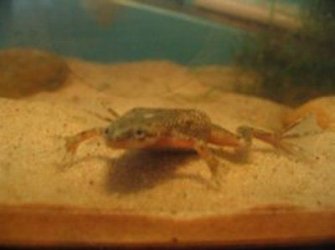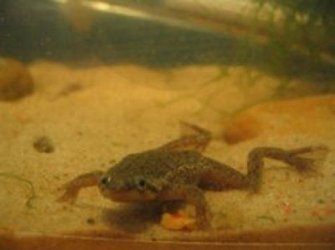emma12321
fish nerd
Common Name : African dwarf frog, congo frog; do not confuse this frog with the African clawed frog (see below)
Scientific Name : Hymenochirus boettgeri or Hymenochirus curtipes
Origin : Central Africa
Family: Pipidae
Max size Up to 1.5 inches.
Care : Most sites recommend a gallon per frog. Only keep dwarfs with peaceful fish, they make ideal tank mates for bettas. I keep 2 dwarf frogs in a 2.5 gallon critter keeper but hope to upgrade and add more frogs soon. The tank should have a secure lid so the frogs can’t escape and the water should be treated with dechlorinator as it should for fish. Ideally frogs should be kept at 21-27 degrees centigrade so unless they are in a warm room a heater is necessary. Filters aren’t necessary if the frogs are alone but I have a sponge filter in with mine and they don’t seem to mind. Beware of internal filters which can trap the frogs delicate legs if they get sucked in, cover it with fine mesh to prevent this from happening if the filter has large gaps. African dwarf frogs prefer their water pH 7.2 – 7.6, mine are at pH 7 and have spawned before so they must be happy. I have sand in the bottom of their tank and they have bog wood covered in java moss to hide under. Avoid large size gravel as they could swallow a piece when they lunge at their food.
Feeding : African dwarf frogs will take most live and frozen insect type foods, mine love bloodworms and brine shrimp. I feed mine every other day and they search for food by smell not sight, they will lunge at each other when looking for food. If they are kept with fish, you can squirt food at them with a turkey baster to ensure they eat before the fish eat it all.
Sexing and breeding : African dwarf frogs are quite hard to sex unless you have a few to compare. Females are usually bigger than males and have a pointier tail. Males are slightly darker and skinnier and their skin looks more bumpy. Adult males have two white bumps one behind either foreleg on their side. There are reports of African dwarf frogs breeding but it is said the tadpoles are hard to raise. Mine spawned twice when their tank was near the window and they received natural daylight, both times they ate the eggs. The male clasps the female for quite some time and she will swim around with him holding on. The eggs are 1-2 mm and float on the surface when first laid. It would be easier to move the parents to another tank than to try moving the eggs as they are very sticky. They should have an air stone running in the tank and the water should be kept at 23 - 27 degrees centigrade then the eggs will hatch in 5-7 days. Newly hatched, the tadpoles are 2.5mm they will need tiny foods such as infusoria until they are big enough to eat microworms then bigger foods such as bloodworms. The tadpoles usually take 4-6 months to turn into frogs.
Comments : There have been reports of African dwarf frogs living for 18 years if properly cared for. Male frogs will sing to females though I haven’t heard the female sing. It sounds like a low buzzing or humming sound. They are said to shed their skin quite often, though I have never found a skin in with mine so perhaps they eat it. Mine know when they are going to be fed and will come to the corner of the tank and stand on their back legs waiting, sometimes they lean backwards and fall over. They are really cute little critters.
How to recognise a dwarf frog : Not to be confused with African Clawed frogs (Xenopus Laevis) Dwarfs have webbing between their feet and tiny black claws. They are never sold in an albino or golden form. Do not keep dwarfs with clawed frogs or they will be eaten. Clawed frogs have no webbing between their front feet and have buggy looking eyes on the top of their head. Dwarfs have flatter looking eyes more towards the sides of the head. Dwarfs also appear skinnier around the waist. They are diurnal and will be out rooting around for most of the day. Clawed frogs grow 5 inches plus and are larger than African dwarf frogs. Another difference is that Clawed frogs need more like 10 gallons per frog.
The first picture is my female frog and the second picture is the male.


Scientific Name : Hymenochirus boettgeri or Hymenochirus curtipes
Origin : Central Africa
Family: Pipidae
Max size Up to 1.5 inches.
Care : Most sites recommend a gallon per frog. Only keep dwarfs with peaceful fish, they make ideal tank mates for bettas. I keep 2 dwarf frogs in a 2.5 gallon critter keeper but hope to upgrade and add more frogs soon. The tank should have a secure lid so the frogs can’t escape and the water should be treated with dechlorinator as it should for fish. Ideally frogs should be kept at 21-27 degrees centigrade so unless they are in a warm room a heater is necessary. Filters aren’t necessary if the frogs are alone but I have a sponge filter in with mine and they don’t seem to mind. Beware of internal filters which can trap the frogs delicate legs if they get sucked in, cover it with fine mesh to prevent this from happening if the filter has large gaps. African dwarf frogs prefer their water pH 7.2 – 7.6, mine are at pH 7 and have spawned before so they must be happy. I have sand in the bottom of their tank and they have bog wood covered in java moss to hide under. Avoid large size gravel as they could swallow a piece when they lunge at their food.
Feeding : African dwarf frogs will take most live and frozen insect type foods, mine love bloodworms and brine shrimp. I feed mine every other day and they search for food by smell not sight, they will lunge at each other when looking for food. If they are kept with fish, you can squirt food at them with a turkey baster to ensure they eat before the fish eat it all.
Sexing and breeding : African dwarf frogs are quite hard to sex unless you have a few to compare. Females are usually bigger than males and have a pointier tail. Males are slightly darker and skinnier and their skin looks more bumpy. Adult males have two white bumps one behind either foreleg on their side. There are reports of African dwarf frogs breeding but it is said the tadpoles are hard to raise. Mine spawned twice when their tank was near the window and they received natural daylight, both times they ate the eggs. The male clasps the female for quite some time and she will swim around with him holding on. The eggs are 1-2 mm and float on the surface when first laid. It would be easier to move the parents to another tank than to try moving the eggs as they are very sticky. They should have an air stone running in the tank and the water should be kept at 23 - 27 degrees centigrade then the eggs will hatch in 5-7 days. Newly hatched, the tadpoles are 2.5mm they will need tiny foods such as infusoria until they are big enough to eat microworms then bigger foods such as bloodworms. The tadpoles usually take 4-6 months to turn into frogs.
Comments : There have been reports of African dwarf frogs living for 18 years if properly cared for. Male frogs will sing to females though I haven’t heard the female sing. It sounds like a low buzzing or humming sound. They are said to shed their skin quite often, though I have never found a skin in with mine so perhaps they eat it. Mine know when they are going to be fed and will come to the corner of the tank and stand on their back legs waiting, sometimes they lean backwards and fall over. They are really cute little critters.
How to recognise a dwarf frog : Not to be confused with African Clawed frogs (Xenopus Laevis) Dwarfs have webbing between their feet and tiny black claws. They are never sold in an albino or golden form. Do not keep dwarfs with clawed frogs or they will be eaten. Clawed frogs have no webbing between their front feet and have buggy looking eyes on the top of their head. Dwarfs have flatter looking eyes more towards the sides of the head. Dwarfs also appear skinnier around the waist. They are diurnal and will be out rooting around for most of the day. Clawed frogs grow 5 inches plus and are larger than African dwarf frogs. Another difference is that Clawed frogs need more like 10 gallons per frog.
The first picture is my female frog and the second picture is the male.







